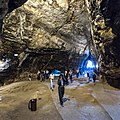Karaftu caves
From Wikipedia, the free encyclopedia
The Karaftu caves[a] (Persian: کرفتو,Kurdish: کەرەفتوو) are an ensemble of artificially cut rock chambers located between Saqqez and Divandarreh, Kurdistan province, Iran. The cave complex dates back to the 3rd or 4th century BC and is of major importance due to its Greek inscription; "one of the very few examples preserved in situ" in Iran.[1]
| Karaftu caves | |
|---|---|
 Karaftu Cave | |
 | |
| Location | Kurdistan province, Iran |
| Coordinates | 36.2667°N 46.8500°E |
| Discovery | 1940 (National Monument registration) |
| Features | Greek inscription, rock-cut architecture |
| Registry | UNESCO Temporary World Heritage List (2022) |

"ʿĒraklēs [ʾenth]ade katoikei, mēthen eiselthoi kakon".
"Herakles resides here, nothing evil may enter"
Alongside the Bisotun Herakles, it represents one of the only extant Seleucid rock-cut artworks.
The rock-cut cave complex dates to the Seleucid era, and likely served as a Seleucid garrison.[2]
UNESCO
This cave was registered as one of Iran's national monuments on February 10, 1940, with registration number 330. Also, this cave was registered in UNESCO's temporary world list on November 15, 2022.[3][4][5]
Gallery
Notes
References
Wikiwand - on
Seamless Wikipedia browsing. On steroids.











